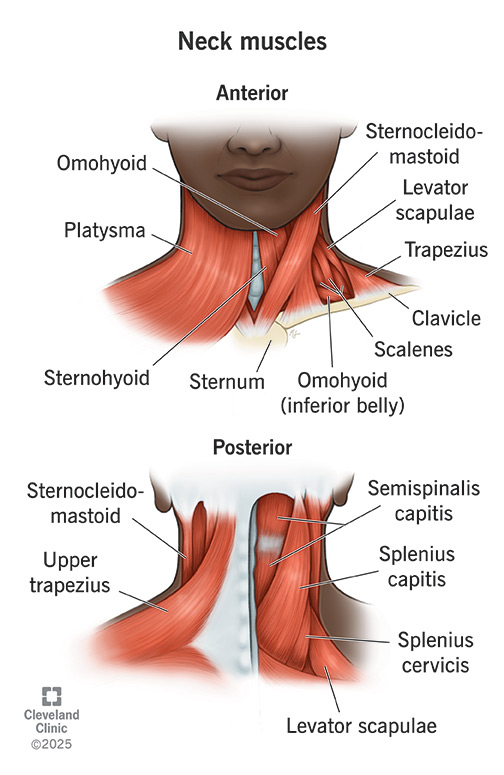You have about 30 neck muscles, extending from the base of your skull and jaw down to your shoulder blades and collarbone. These muscles support and stabilize your head, neck and the upper part of your spine. They help you move your head in different directions and assist with chewing, swallowing and breathing.
Advertisement
Cleveland Clinic is a non-profit academic medical center. Advertising on our site helps support our mission. We do not endorse non-Cleveland Clinic products or services. Policy

Your neck muscles are part of a complex musculoskeletal system (soft tissues and bones) that connects the base of your skull to your torso (trunk). Muscles contain fibers that contract (get smaller), allowing you to perform lots of different movements. The muscles of your neck help you do everything from chewing and swallowing to moving your head.
Advertisement
Cleveland Clinic is a non-profit academic medical center. Advertising on our site helps support our mission. We do not endorse non-Cleveland Clinic products or services. Policy
The muscles in your neck are skeletal muscles, meaning they’re attached to bones by tendons. They’re voluntary muscles, so you control how they move and work.
Neck muscle injuries like strains can be painful but aren’t usually cause for alarm. In rare cases, serious neck injuries need immediate medical attention.
Your neck muscles serve a variety of functions, including:
Your neck muscles are at the front, sides and back of your neck. From the back, they begin just beneath the base of your skull and extend down near the middle of your back, around your shoulder blades. From the front, these muscles begin at your jaw and extend to your collarbone (clavicle) at the top of your chest.
There are three main categories of neck muscles: anterior (front), lateral (side) and posterior (back). They can be further broken down by type.
Anterior neck muscles are arranged in four distinct regions, including superficial, suprahyoid, infrahyoid and scalene muscles.
Advertisement
Your superficial muscles are some of the largest muscles in your neck. They include:
Your suprahyoid muscles move your hyoid bone (a bone at the top of your neck, just below your jawline) when you swallow and speak. They include:
Your infrahyoid muscles are four muscles below your hyoid bone that move your larynx (voice box) up and down. They include:
Your scalene muscles move your first two ribs up and down so you can inhale air when you breathe. They also help move your head and stabilize the bones in your neck (cervical spine). They include:
Your lateral neck muscles control head movements from the base of your skull. They also help you twist your head from side to side and twist and tilt your cervical spine. They include:
Types of posterior neck muscles include superficial, suboccipital and transversospinalis.
Your superficial muscles are strap-like muscles in the back of your neck that help you extend and rotate your head. They include:
Your suboccipital muscles are just below the occipital bone at the base of your skull. They help extend your head in different directions. They include:
Your transversospinalis muscles help you move your head forward and backward, as well as tilt it from side to side. They also help stabilize your spine and move the cervical, thoracic and lumbar regions of your spine. They include:
Like all other skeletal muscles in the body, the muscles in your neck contain lots of tiny, elastic fibers that allow the muscles to contract. Sheaths of tough connective tissue hold the fibers together. Skeletal muscle fibers are red and white, so the muscles look striped or streaked (striated).
Common conditions that affect your neck muscles include:
Neck injuries may cause:
Advertisement
You have about 30 muscles in your neck that allow you to perform a variety of movements. These muscles stabilize and support your head and upper back. They also help you chew, make facial expressions and breathe. So, it’s important to keep your neck muscles strong and healthy. You can do that by maintaining good posture and paying attention to your body’s signals. Don’t ignore continued pain, weakness in your arms or headache/neck stiffness.
Advertisement
From sudden injuries to chronic conditions, Cleveland Clinic’s orthopaedic providers can guide you through testing, treatment and beyond.

Last reviewed on 02/11/2025.
Learn more about the Health Library and our editorial process.